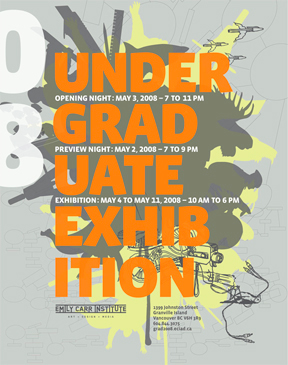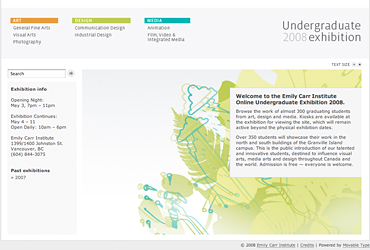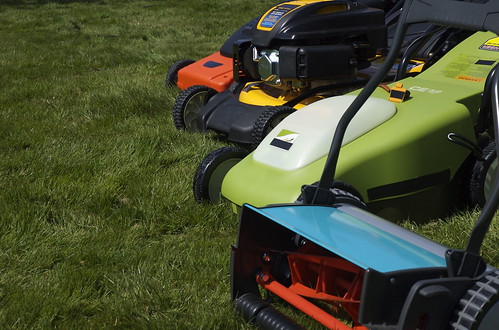
Photo by Rob_ on Flickr
Yesterday I joined my sister and my little nieces to one of several Car-Free Vancouver festivals. It was almost surreal to see a chunk of Main St. filled with people, “dancing in the stree-eet,” with absolutely no cars. The warm air was filled with various music, voices, children’s laughter, and sometimes the crashing and bumping noises of skateboarders on the half-pipe. We enjoyed a live performance from a guitarist/singer + DJ/violinist duo that would probably be called lounge jazz pop? The kids had some fun dancing to it. While the next band set up some dancers moved to, I think it was flamenco music, with various dance props (ribbons, etc.) The girls had their faces painted — a butterfly and a lovebug (ladybug on one cheek, heart on the other) — and posed for some adorable photos!
Continue reading Car-Free Vancouver Day »
Tonight the Vancouver Public Library is hosting a screening of the film, The Power of Community: How Cuba Survived Peak Oil, as part of its Necessary Visions series. It’s a free program and will be held at their Central branch, downtown at 350 West Georgia. Details below, and more events at the VPL website. Hope to see you there.
The Power of Community: How Cuba Survived Peak Oil is a project of The Community Solution, a non-profit organization that designs and teaches low-energy solutions to the current unsustainable, fossil fuel based, industrialized, and centralized way of living.”
— the Power of Community website

Screening info
Friday June 6, 7:30 pm
Alice MacKay Room, Lower Level
When the Soviet Union collapsed in 1990, Cuba’s economy went into a tailspin. With imports of oil cut by more than half — and food by 80 percent — people were desperate. This film tells of the hardships and struggles as well as the community and creativity of the Cuban people. They share how they transitioned from highly mechanized agriculture to using organic farming and urban gardens.
The Necessary Visions series features screenings of locally made documentary films, followed by discussion afterwards with the filmmakers.
For more information please contact Vancouver Public Library at 604-331-3603. Sponsored by Necessary Voices and Cinema Politica.
—
POST-EVENT UPDATE: This film is excellent! The turnout was impressive — two hundred people maybe? — of all ages and I do believe everyone truly enjoyed it. Lots to think about, be inspired by, and make strides towards. I took 3 journal-sized pages of notes and that’s like 4.5 pages for a person with normal-sized handwriting. A small country with a truly remarkable recent history, Cuba is an example for the world on how to live. Shocking statistics revealed visually the massive differences between their way of life and that of Americans: they use one eighth of the energy and yet maintain the same (if not better) life expectancy. Given that diabetes and heart disease rates have dropped in Cuba, but the opposite is happening in the US where we forecast life expectancy to drop for the first time, I don’t doubt that a gap will start to appear. It is probably time that the US started looking to Cuba as a model for sustainable living, rather than shunning them. Not that Cuba appears to need them anymore! They’ve got it all figured out.
Celsias posted a shocking film, Patent for a Pig: The Big Business of Genetics (43 mins) with some grim truths about Monsanto that are beyond frightening. I find it hard enough to comprehend sometimes that we place a monetary value on something nature alone created, e.g. selling your cat’s litter or some plants that appeared in your backyard. (Breeding/raising is a bit different as there is work input into the result, but it’s still animals creating animals.) I’ll let the film tell the details, with this intro from the Celsias post:
It’s amazing what humankind can do with a little effort and ingenuity. Who’d a thought we could create an intelligent, four legged creature with a curly tail, that actually walks and makes cute grunting noises?
Stand by to be horrified at the lengths Big Biotech will go to take over the world’s food supplies. You’ll also be shocked to learn that pig and cattle farmers are seeing their livestock go sterile due to giving them genetically modified feed.
“Introducing Monsanto, the inventors of the pig…”
Thanks to my mother for the heads up on this item.

It figures it’s been a month and a half since I wrote Part 1 and said it would be “a couple weeks.” I have a legitimate excuse, however: the topic on which I desperately wanted to write was (is!) getting bigger and bigger as news stories and blog posts flooded the papers and internet on the topic. An overwhelming amount of information to sort through, half of it’s out of date by now and much of it I haven’t yet read.
My blogging has been sparse at best lately, and this behemoth of a topic isn’t helping. Of course I’d also like to write about everything! But whilst I muster up the energy/time to do this, here are my key points:
– global food crisis overview
– modern agriculture… permaculture… what our monoculture system + pesticide/herbicide use did to our natural systems: reducing yield, damaging and polluting the earth, losing diversity, bringing in GMO which is proven to harm humans
– hoarding: it’s human nature
– food wastage (also see BBC article)
– oil: peak oil, pesticides, the benefits of local eating
– community and personal gardening
– developers get (potentially large) tax credit by turning land into “public land” while waiting for a project to get underway, then can install a community garden, makes them look socially responsible
PHEW!
Well, now that I’ve got a few hours of my life per week back from the brain-sucking, life-wasting machine called the Television (I watch mostly intelligent programming, but it’s TV nonetheless), I should have few excuses not to sit down and churn this out. Unless, of course, I get distracted by Stephen Rees’s blog.
And now it’s time for bed, but I will leave you with this tidbit and links, and inform you that I’m still alive!

A new blogger action initiative just launched this week. Brighter Planet, “a Vermont start-up committed to fighting climate change and building a clean-energy future,” will offset 350 pounds of carbon for every blogger who puts the badge on their blog (let them know you’ve done it, via the form on the campaign website in order to make it count). Their goal is to get 350 bloggers on board, to offset 122,500 pounds of carbon! “That’s like flicking off 100 lightbulbs for a day. Or going two full weeks without your car!”
I encourage you to sign up to put the nifty, fun badge on your blog, too.

Near the entrance to Granville Island on Saturday I was stunned to see a heritage trolley car on the old tracks at “Granville Station.” They have tours every weekend now — did anyone else know about this? What a pleasant surprise!

Saturday night I attended the ever-popular Emily Carr Undergraduate Exhibition, more commonly referred to as the “grad show” among my peers. There is some stellar work there, as always, and I strongly encourage anyone interested in art, communication design, industrial design, film or animation to get down there in the coming week and see the work of this year’s group of 350+ talents.
The show runs for a shorter period this year so you only have until this coming Sunday the 11th to see it for yourself! The show is open 10 am to 6pm at Emily Carr Institute, 1399/1400 Johnston St. on Granville Island. More info »
For myself and my class, today marks one year since our graduation and grad show… how time flies! The feeling walking to the show opening on that perfect sunny evening and the energy of the night itself has a nostalgic magic.

This year I helped put out the grad site again but with a much different set of roles. The student volunteers and coordinating faculty gave a tremendous effort; many thanks and congratulations go out to them for producing a fabulous grad 2008 website!
Note that many projects showing at the school are not on the website, and vice versa. This is particularly true of design projects which were not yet complete at the time of submission. So do visit the show, pick up a printed catalogue, and check out the website. Enjoy!
On Saturday I attended a forum put on by VALTAC (Valley Transportation Advisory Committee), hosted at the Langley Township Hall. (Nice building!) It was a statement toward our poor transit network South of the Fraser that all five speakers drove to the venue. Stephen Rees joked that the TransLink trip planner wouldn’t even give him a trip itinerary because it would take either more than 3 hours or more than 3 transfers. My proximity to the Hall made it easy enough to get there, if you consider a bus late by 7 minutes then a 20-minute walk easy. And Langley isn’t exactly known for being pedestrian-friendly.
The forum was about getting better public transportation South of the Fraser, mainly via rail connections. There is much support for one solution, spearheaded by a group called Rail for the Valley, which would reinstate the Interurban that ran from about 1900 to 1950 all the way from Vancouver to Chilliwack. Maps at the venue showed the dense urban centres through which this rail line passes. (Today it is used only for freight.)
Continue reading Event recap: VALTAC forum on Rail for the Valley »
On Saturday, I went to the EPIC expo at Canada Place. The main attraction for me was a talk by Adria Vasil, author of a best-selling book I adore called Ecoholic. In her inspiring presentation, she gave us a history behind the book’s development and noted how the green movement was virtually non-existent when she started her column in 2004. Organizers of EPIC apparently wanted to put on this event back then but there was deemed to be a lack of interest in green issues.
Adria offered some great advice and encouragement for greening one’s lifestyle: choose three things every month and do them. No matter how good you are already, you can do even better. My three things? I decided to no longer buy greenhouse-grown produce, I switched to compostable plastic bags for my garbage and replaced some of my soap with a locally-made, more natural product (and it smells divine, too!) Adria emphasized the importance of individual actions and how even little things add up. Case in point: the government’s new green product claims regulation is consumer complaint-driven, meaning it’s up to us to call in and report on products that (we think) are making false claims. So things are looking up, anyway. Adria is very lovely and was happy to sign my Ecojot notebook (I had not brought my copy of Ecoholic).
Continue reading EPIC – Sustainable living expo »

Thanks to Darren Barefoot for the photo and for telling me about the following tip.
The Clean Air Foundation‘s Mow Down Pollution program is once again taking a good jab at ol’ Mr. Smoggy, the Lawn Mower Hog himself, by educating the public about the significant amount of greenhouse gases and air pollution we can prevent by retiring the ol’ stinker and replacing it with a more earth-friendly alternative. Ever since I saw one of those push mowers, I had been suggesting my dad look into it, to replace the gas one. Some credit can be given for its long lifespan, but it’s noisy, it stinks and heck, it’s so hard to push that he got stuck with the job every time. Besides, the push mower is good for the grass! We’re eco-friendly folk, so knowing just how much a gas-powered lawn mower actually emits over time is pretty enlightening. And a $100 instant rebate? Talk about motivation! Here are the deets:
Continue reading Cut your lawn and CO2 at the same time »








